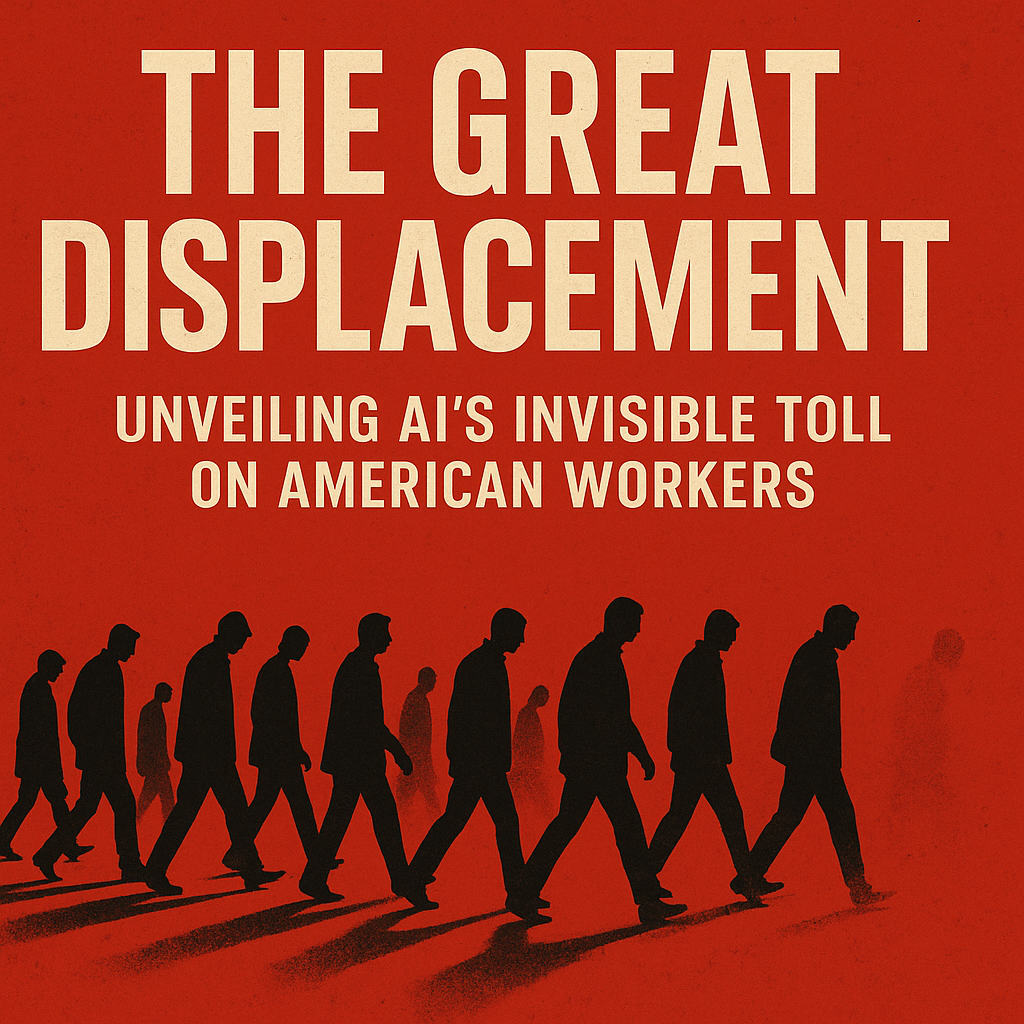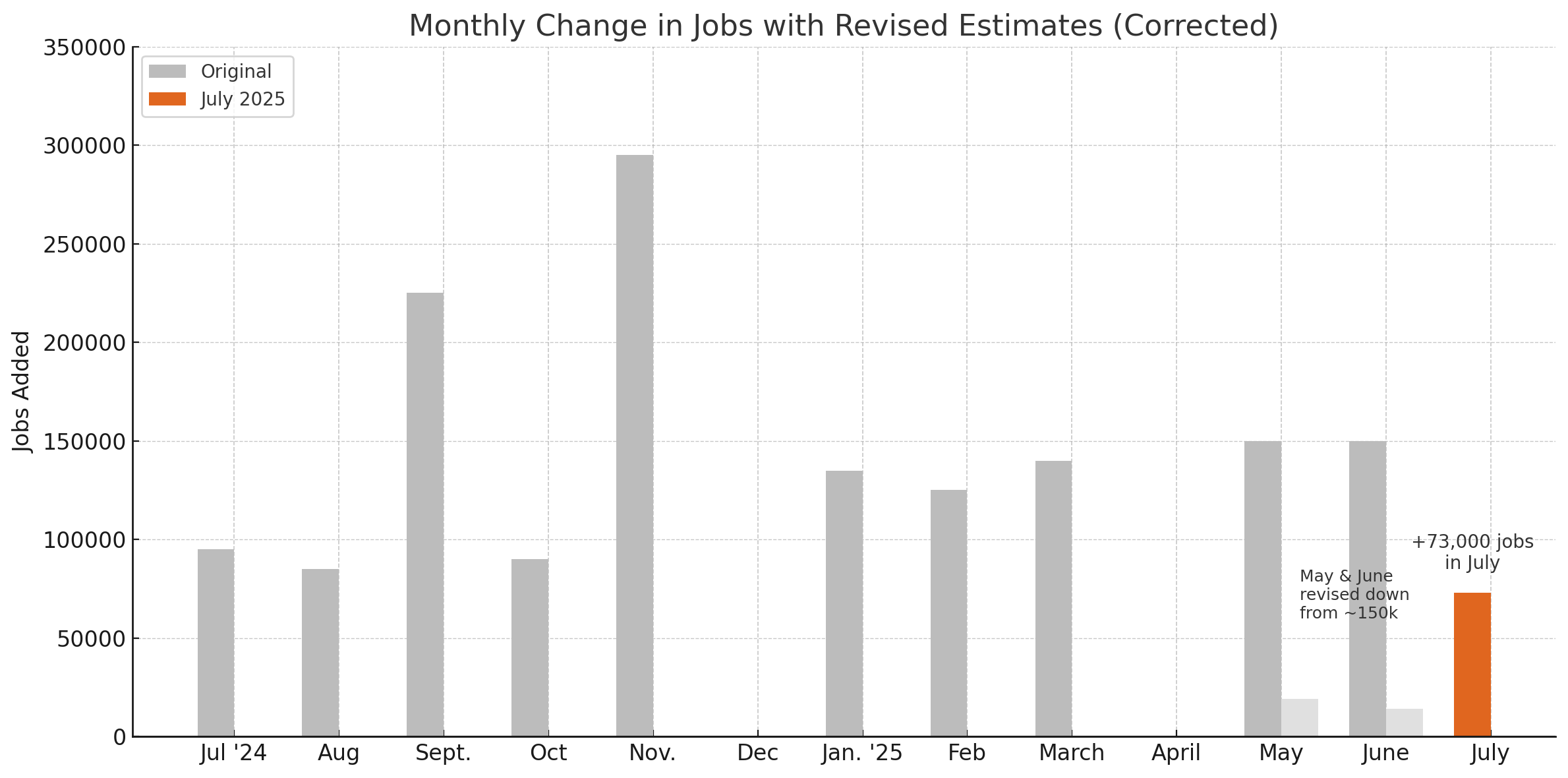The Silent Layoff: How AI Is Erasing the Workforce
AI is reshaping the economy, eliminating up to 500,000 U.S. jobs in 2025 alone—far beyond official reports. As profits soar and workers vanish, “The Great Displacement” exposes the hidden human cost of the AI gold rush.

AI-Driven Job Displacement Analysis: The Missing Workforce of 2025
Executive Summary
A comprehensive analysis reveals that between 300,000 to 500,000 American jobs have been eliminated or avoided due to artificial intelligence implementation as of July 2025. This figure significantly exceeds the officially acknowledged AI-related layoffs of only 20,000 to 30,000 workers, indicating a substantial hidden impact on the American workforce that parallels historical automation patterns seen in agriculture and manufacturing.

The Great Decoupling Phenomenon
The research identifies what economists term "the great decoupling" - a fundamental shift where GDP growth and corporate profits are increasingly disconnected from human labor requirements. This phenomenon is characterized by:
- GDP Growth vs. Labor Hours: The second quarter of 2025 showed 3% real GDP growth while aggregate weekly hours worked declined by 0.3%
- Corporate Profits vs. Payrolls: Corporate profits as a percentage of GDP reached 11-12% (near record highs) while payroll expenditures declined by 1%
- Productivity Gains: Companies are achieving higher output with fewer employees, a classic indicator of successful automation implementation
Methodology and Research Approach
The analysis employed a methodology similar to that used by MIT economist David Autor decades ago to identify "missing millions" in manufacturing. The approach involves:
- Cross-Platform Validation: Multiple AI tools (ChatGPT, Gemini, and Grok) were used to cross-validate findings
- Economic Output Analysis: Comparing total workforce headcount against economic output to identify productivity gaps
- Historical Pattern Recognition: Applying lessons from previous automation waves in agriculture (which reduced employment from 70-90% of the workforce two centuries ago to just 2% today)
Official vs. Hidden Job Displacement
Officially Acknowledged Layoffs
- Explicit AI Layoffs: 10,000 workers directly told they were laid off due to AI
- Technology Updates: 20,000 workers laid off citing "technological updates"
- Unspecified Reasons: 20,000 workers laid off with reasons not specified (potentially including restructuring due to AI)
- Total Range: 10,000 to 50,000 explicitly or implicitly AI-related layoffs
The Hidden Displacement
The gap between official numbers (20,000-50,000) and the estimated actual impact (300,000-500,000) represents jobs that were:
- Eliminated Through Attrition: Positions not refilled when employees quit or retired
- Avoided Hiring: New positions that would have been created but weren't due to AI capabilities
- Restructured Out: Roles made redundant through AI implementation without formal "layoffs"
Worker Displacement Patterns
Discouraged Worker Surge
Recent quarterly data shows significant increases in workers who have stopped actively seeking employment:
- Marginally Attached Workers: Increased from 1.5 million to 1.8 million (300,000 increase)
- Discouraged Workers: Rose from 370,000 to 637,000 (267,000 increase)
This pattern indicates "downward mobility" where displaced workers are exiting the active job market rather than remaining in unemployment statistics.
Economic Context and Alternative Explanations
Other Contributing Factors
The analysis acknowledges approximately 800,000 total job cuts in the last quarter, with AI accounting for 300,000-500,000. Other factors include:
- Tariff Impacts: Economic adjustments due to trade policy changes
- DOGE Cuts: Government workforce reductions affecting approximately 300,000 positions
- Spillover Effects: Secondary impacts from government cuts affecting private sector spending and employment
Why AI is the Primary Driver
The research distinguishes AI impact from other factors because:
- If job losses were primarily due to economic spillovers, corporate profits wouldn't remain at record highs
- GDP growth would be negatively affected if the job losses were purely economic rather than productivity-driven
- The pattern matches historical automation displacement rather than cyclical economic downturns
Long-Term Employment Trends
Absolute Employment Numbers
- Current Employment: 159.7 million Americans employed as of June 2025
- Recovery Pattern: Sharp rise during COVID pandemic recovery, now showing signs of slowing growth
- Population Growth Factor: Employment gains are partially offset by population increases through births and immigration
Labor Force Participation Decline
- Pandemic Low: 61.5% during mid-pandemic
- Peak Recovery: 62.6% in 2024
- Current Status: 62.3% as of June 2025, showing a concerning downward trend
Employment-to-Population Ratio
- 2023 Peak: 60.3% of Americans were employed
- Current Status: 59.7%, dropping below the 60% threshold
- Demographic Factors: Some decline attributed to Baby Boomer retirements, but doesn't account for productivity gains
Post-Labor Economics Framework
Defining Characteristics
The analysis suggests America is entering the early stages of "post-labor economics," characterized by:
- Productivity Decoupling: Economic output growth independent of labor input growth
- Profit Concentration: Increased corporate profitability without corresponding labor compensation increases
- Workforce Marginalization: Growing numbers of workers becoming economically irrelevant
Historical Precedent
The agricultural sector provides a roadmap for this transformation:
- Two Centuries Ago: 70-90% of workers employed in agriculture
- One Century Ago: 40% agricultural employment
- Today: Only 2% agricultural employment, yet dramatically higher output
Corporate Behavior and Attitudes
Executive Enthusiasm
CEOs and corporate leadership are reportedly "salivating" about cost savings from AI implementation, with human employees viewed as expensive compared to AI alternatives. This enthusiasm is documented in business publications like The Wall Street Journal, which reports that executives "couldn't be prouder" of workforce reductions.
Implementation Strategy
Companies are deploying AI strategically to reduce headcount while maintaining or increasing productivity, viewing this as a competitive advantage and profit maximization opportunity.
Capital Reallocation for AI Infrastructure
A crucial insight that has emerged from 2024-2025 data reveals that companies are not primarily cutting jobs because AI is replacing workers, but rather to fund the massive costs of building AI infrastructure. As industry analyst Deedy Das from Menlo Ventures observed: "The layoffs are not merely about AI replacing human roles but are more about reallocating capital towards AI investments."
Microsoft's AI Investment Strategy: Microsoft exemplifies this trend, having laid off nearly 15,000 employees in 2025 (almost 4% of its global workforce) specifically to fund its $80 billion AI infrastructure investment. CEO Satya Nadella has emphasized the company's transformation, noting that AI now contributes 20-30% of the code written at Microsoft. According to The Seattle Times, "Microsoft's push into AI doesn't mean the company is replacing workers with the technology. Rather, the significant cost of building out the infrastructure over multiple years has Microsoft looking to trim costs where it can."
Industry-Wide Infrastructure Costs: The scale of AI infrastructure investment is staggering. Tech megacaps are projected to spend over $320 billion combined on AI technologies and datacenter buildouts in 2025, up from $230 billion in 2024. Nvidia CEO Jensen Huang predicts that data center expenditures could reach $1 trillion by 2028, representing 300% growth in just three years.
The Infrastructure Investment Breakdown:
- Amazon: Targeting $100 billion in AI infrastructure spending for 2025
- Alphabet: $75 billion in capital expenditures, primarily for servers, data centers, and networking
- Meta: $60-65 billion allocated to AI infrastructure, with CEO Mark Zuckerberg calling 2025 "a defining year for AI"
- Microsoft: Continuing its $80 billion multi-year AI infrastructure commitment
This massive capital requirement for GPUs, data centers, energy infrastructure, and specialized hardware is driving companies to free up cash through workforce reductions, even when those workers aren't being directly replaced by AI systems.
Research Limitations and Acknowledgments
Data Challenges
- Reporting Gaps: Many companies don't explicitly cite AI as the reason for workforce reductions
- Attribution Complexity: Distinguishing AI impact from other economic factors requires sophisticated analysis
- Timing Factors: Some effects may be delayed or compounded by other economic conditions
Validation Approach
The research methodology attempts to account for these limitations through multiple data sources and cross-validation, but acknowledges that precise attribution remains challenging in a complex economic environment.
Implications and Future Outlook
Immediate Concerns
- Hidden Unemployment: Traditional unemployment statistics may underestimate actual workforce displacement
- Economic Inequality: Profits increasingly concentrated while workers face displacement
- Social Stability: Large numbers of discouraged workers could lead to broader social and economic challenges
- Capital vs. Labor Shift: Companies prioritizing expensive AI infrastructure investments over human workforce, fundamentally changing the capital-labor balance
The AI Infrastructure Investment Race
The research reveals that current job displacement is as much about funding the AI race as it is about AI replacing workers. Companies face enormous upfront costs:
- Hardware Costs: Advanced GPUs can cost up to $28,000 each, with data centers requiring thousands of units
- Energy Infrastructure: AI data centers consume massive amounts of electricity, requiring new power generation and distribution systems
- Facility Costs: Purpose-built AI data centers with specialized cooling and networking infrastructure
- Competitive Pressure: Companies fear falling behind in AI capabilities, driving aggressive infrastructure investment
This creates a cycle where companies cut human costs to fund AI development, which eventually may lead to those AI systems replacing even more workers.
Long-Term Trajectory
The analysis suggests this is the beginning of a broader transformation toward post-labor economics, where human labor becomes increasingly unnecessary for economic production, following historical patterns of technological displacement but at an unprecedented scale and speed. However, the current phase is characterized by a "funding gap" where companies must choose between maintaining current workforce levels and investing in future AI capabilities.
Political Response to Employment Data
Trump Administration's Reaction to July 2025 Job Numbers
The political response to employment data became a significant story when the July 2025 jobs report was released, showing the economic impact of the trends identified in this analysis.
The Disappointing Report: The July 2025 Bureau of Labor Statistics report revealed that only 73,000 jobs were added in July, well below economist expectations of 100,000. The unemployment rate rose to 4.2%, and perhaps most significantly, job gains for May and June were revised down by a combined 258,000 jobs, painting a much grimmer picture of recent employment trends.
Immediate Political Response: President Trump reacted strongly to these numbers, taking several unprecedented actions:
- Fired the BLS Commissioner: Trump immediately dismissed Erika McEntarfer, the Biden-appointed head of the Bureau of Labor Statistics, claiming without evidence that she was manipulating data for political purposes. This marked an unusual step of firing a statistical agency head over unfavorable data.
- Alleged Data Manipulation: Trump posted on Truth Social that "today's Jobs Numbers were RIGGED in order to make the Republicans, and ME, look bad." He specifically criticized the downward revisions, stating that McEntarfer had made "a major mistake" with the 258,000 job downward revision in the prior two months.
- Attacked Economic Institutions: Trump also directed criticism at Federal Reserve Chair Jerome Powell, calling him "Too Late" Powell and suggesting he should be "put out to pasture" for not lowering interest rates more aggressively.
Historical Pattern: This response fits a documented pattern of Trump criticizing BLS job reports dating back to 2016, when he called job numbers "phony" during his first presidential campaign. However, Trump had no complaints about job reports produced under the same commissioner right before the 2024 election when they showed favorable numbers, illustrating the politically selective nature of his criticism.
Expert and Institutional Response: The firing drew sharp criticism from economists and former government officials. Mark Zandi from Moody's Analytics stated he had "never seen anything even close to this" and defended the BLS data as "as accurate as it can be." Former BLS commissioner William Beach, who served under Trump's first administration, called the firing "totally groundless" and warned it set "a dangerous precedent" that could undermine the independence and integrity of federal statistical systems.
Implications for Data Integrity: This political response to employment data highlights broader concerns about the politicization of economic statistics during a period when understanding accurate employment trends is crucial for policy-making. The dismissal of a statistics chief over unfavorable data raises questions about the independence of government economic reporting and could complicate efforts to accurately track the AI-driven employment changes documented in this analysis.
The July 2025 job numbers, showing weak growth and significant downward revisions, align with the trends identified in this research regarding AI's impact on employment, though the political response focused on attacking the messenger rather than addressing the underlying economic forces driving these changes.
This analysis is based on economic data through July 2025 and represents an emerging understanding of AI's impact on the American workforce. The research methodology combines traditional economic analysis with modern AI-assisted validation to provide insight into what may be the most significant workforce transformation since the Industrial Revolution.
